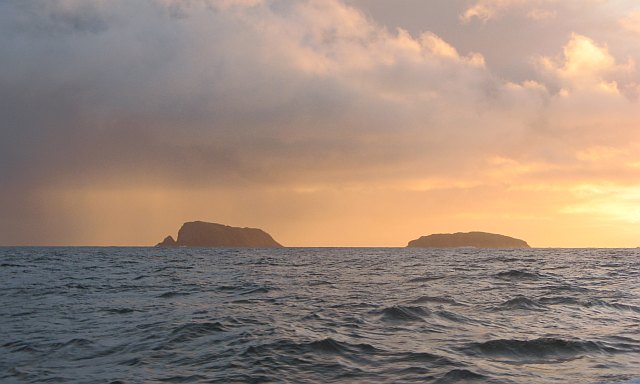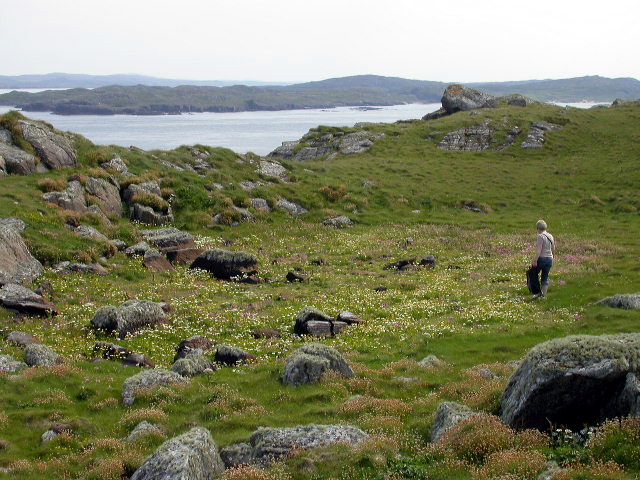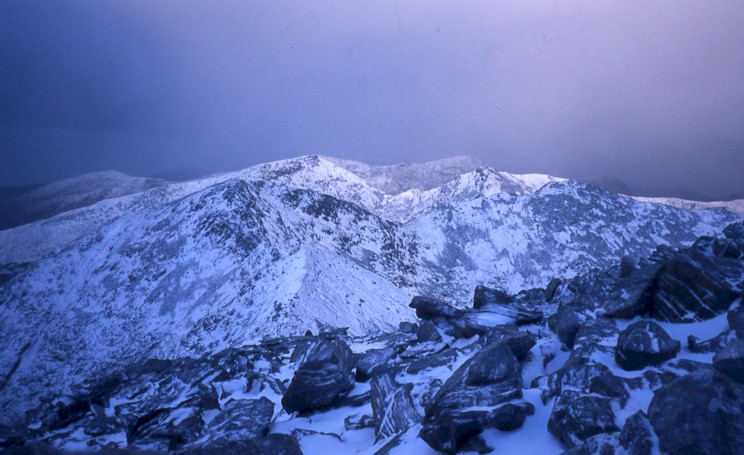|
Bearasaigh
Bearasaigh or Bearasay (and sometimes Berisay) is an islet in outer Loch Ròg, Lewis, Scotland. During the late 16th and early 17th centuries it was used as a pirates' hideout and the remains of various buildings from that period still exist. In the modern era its cliffs are used for rock-climbing. Geography Bearasaigh lies north west of Great Bernera, Little Bernera and Flodaigh (flat island) and south of Seanna Chnoc (old hill). Although steep-sided the isle has a relatively flat summit. Immediately to the west is Stac an Tùill and there is a sea cave to the north east. The deep sea channel between Bearasaigh and Seanna Chnoc is said to be "troublesome" when the wind opposes the tidal current. Pirate's redoubt In the 16th century the island was the retreat of Neil MacLeod, the Lewis patriot and illegitimate son of the clan chief of the MacLeods of Lewis, Old Ruari. In 1598 King James VI had authorised some " Gentleman Adventurers" from Fife to civilise the "most barbarou ... [...More Info...] [...Related Items...] OR: [Wikipedia] [Google] [Baidu] |
Berisay - Geograph
Bearasaigh or Bearasay (and sometimes Berisay) is an islet in outer Loch Ròg, Lewis, Scotland. During the late 16th and early 17th centuries it was used as a pirates' hideout and the remains of various buildings from that period still exist. In the modern era its cliffs are used for rock-climbing. Geography Bearasaigh lies north west of Great Bernera, Little Bernera and Flodaigh (flat island) and south of Seanna Chnoc (old hill). Although steep-sided the isle has a relatively flat summit. Immediately to the west is Stac an Tùill and there is a sea cave to the north east. The deep sea channel between Bearasaigh and Seanna Chnoc is said to be "troublesome" when the wind opposes the tidal current. Pirate's redoubt In the 16th century the island was the retreat of Neil MacLeod, the Lewis patriot and illegitimate son of the clan chief of the MacLeods of Lewis, Old Ruari. In 1598 King James VI had authorised some " Gentleman Adventurers" from Fife to civilise the "most barbarous ... [...More Info...] [...Related Items...] OR: [Wikipedia] [Google] [Baidu] |
Peter Love
Peter Love (died 1610) was an English pirate, said to have been born in Lewes, Sussex. He was the captain of the ''Priam'', and for a time occupied a base on the Isle of Lewis, in the Outer Hebrides, when he entered into an agreement with the Hebridean outlaw Neil MacLeod. From his base of operations on Lewis, Love captured numerous ships and seized their cargo. MacLeod, however, betrayed Love, and handed him over to the Scottish authorities. As a result, Love and several members of his crew were found guilty of piracy and condemned to be hanged, in 1610. MacLeod did not much outlive Love, since he was betrayed by his kinsman, Rory Mor MacLeod of Harris and Dunvegan, and executed for high treason three years later. Background Peter Love was stated to have been born in Lewes, Sussex, England, some time in the 16th century. He was a notable pirate of his era; his ship was called the ''Priam''. Allegiance with the outlaw Neil MacLeod According to early 20th-century historian Willi ... [...More Info...] [...Related Items...] OR: [Wikipedia] [Google] [Baidu] |
Outer Hebrides
The Outer Hebrides () or Western Isles ( gd, Na h-Eileanan Siar or or ("islands of the strangers"); sco, Waster Isles), sometimes known as the Long Isle/Long Island ( gd, An t-Eilean Fada, links=no), is an island chain off the west coast of mainland Scotland. The islands are geographically coextensive with , one of the 32 unitary council areas of Scotland. They form part of the archipelago of the Hebrides, separated from the Scottish mainland and from the Inner Hebrides by the waters of the Minch, the Little Minch, and the Sea of the Hebrides. Scottish Gaelic is the predominant spoken language, although in a few areas English speakers form a majority. Most of the islands have a bedrock formed from ancient metamorphic rocks, and the climate is mild and oceanic. The 15 inhabited islands have a total population of and there are more than 50 substantial uninhabited islands. The distance from Barra Head to the Butt of Lewis is roughly . There are various important preh ... [...More Info...] [...Related Items...] OR: [Wikipedia] [Google] [Baidu] |
Ordnance Survey
Ordnance Survey (OS) is the national mapping agency for Great Britain. The agency's name indicates its original military purpose (see ordnance and surveying), which was to map Scotland in the wake of the Jacobite rising of 1745. There was also a more general and nationwide need in light of the potential threat of invasion during the Napoleonic Wars. Since 1 April 2015 Ordnance Survey has operated as Ordnance Survey Ltd, a state-owned enterprise, government-owned company, 100% in public ownership. The Ordnance Survey Board remains accountable to the Secretary of State for Business, Energy and Industrial Strategy. It was also a member of the Public Data Group. Paper maps for walkers represent only 5% of the company's annual revenue. It produces digital map data, online route planning and sharing services and mobile apps, plus many other location-based products for business, government and consumers. Ordnance Survey mapping is usually classified as either "Scale (map), large-sc ... [...More Info...] [...Related Items...] OR: [Wikipedia] [Google] [Baidu] |
High Treason
Treason is the crime of attacking a state authority to which one owes allegiance. This typically includes acts such as participating in a war against one's native country, attempting to overthrow its government, spying on its military, its diplomats, or its secret services for a hostile and foreign power, or attempting to kill its head of state. A person who commits treason is known in law as a traitor. Historically, in common law countries, treason also covered the murder of specific social superiors, such as the murder of a husband by his wife or that of a master by his servant. Treason (i.e. disloyalty) against one's monarch was known as ''high treason'' and treason against a lesser superior was ''petty treason''. As jurisdictions around the world abolished petty treason, "treason" came to refer to what was historically known as high treason. At times, the term ''traitor'' has been used as a political epithet, regardless of any verifiable treasonable action. In a civil war o ... [...More Info...] [...Related Items...] OR: [Wikipedia] [Google] [Baidu] |
King James VI Of Scotland
James VI and I (James Charles Stuart; 19 June 1566 – 27 March 1625) was King of Scotland as James VI from 24 July 1567 and King of England and Ireland as James I from the union of the Scottish and English crowns on 24 March 1603 until his death in 1625. The kingdoms of Scotland and England were individual sovereign states, with their own parliaments, judiciaries, and laws, though both were ruled by James in personal union. James was the son of Mary, Queen of Scots, and a great-great-grandson of Henry VII, King of England and Lord of Ireland, and thus a potential successor to all three thrones. He succeeded to the Scottish throne at the age of thirteen months, after his mother was compelled to abdicate in his favour. Four different regents governed during his minority, which ended officially in 1578, though he did not gain full control of his government until 1583. In 1603, he succeeded Elizabeth I, the last Tudor monarch of England and Ireland, who died childless. He ... [...More Info...] [...Related Items...] OR: [Wikipedia] [Google] [Baidu] |
Roderick Macleod Of Macleod
Sir Rory MacLeod, 15th Chief of MacLeod (c1559–1626), also known as Roderick Macleod ( Scots Gaelic: Ruairidh Mór 'Rory the Great'), was the 15th Chief of Clan MacLeod and one of the most famed and notorious chiefs of that clan. Biography Roderick MacLeod of MacLeod, also known as "Rory Mor" or "Ruairidh Mor", was born in Dunvegan, Scotland in 1573 and was the 15th chief of the Clan MacLeod. He was the second son of Norman MacLeod of MacLeod (c. 1516-1585) the 12th chief of the Clan MacLeod. He became chief upon the death of his young nephew in 1595. He married Elizabeth MacDonald, daughter of the 8th Chief of Clan MacDonald of Glengarry circa 1598. Together they had 11 children, 5 sons and 6 daughters including: * Margaret MacLeod of Macleod, who married Hector Mor Maclean, 16th Chief of Clan Maclean; * Mary MacLeod of Macleod who married Sir Lachlan Maclean, 1st Baronet and 17th Chief of Clan Maclean; * Ian Mor Macleod of Macleod, 16th Chief (died 1649), who married Sy ... [...More Info...] [...Related Items...] OR: [Wikipedia] [Google] [Baidu] |
Harris, Outer Hebrides
Harris ( gd, Na Hearadh, ) is the southern and more mountainous part of Lewis and Harris, the largest island in the Outer Hebrides, Scotland. Although not an island itself, Harris is often referred to in opposition to the ''Isle of Lewis'' as the Isle of Harris, which is the former postal county and the current post town for Royal Mail postcodes starting HS3 or HS5. The civil parish of Harris is considered to include St Kilda, an uninhabited archipelago west-northwest of North Uist, and the uninhabited islet Rockall, which is west of North Uist. Etymology Harris originates from the Old Norse name Harri, the diminutive of the name Harald. Variants are the Dutch Harrie and the Flemish Hariche. Refer also to country and source abbreviations on page 15 These names derive from the Old Norse root word " hár", meaning "high", with the comparative being "hærri". In the English language name, the addition of the "s" once indicated the plural. The Vikings arrived in the ... [...More Info...] [...Related Items...] OR: [Wikipedia] [Google] [Baidu] |
Leith
Leith (; gd, Lìte) is a port area in the north of the city of Edinburgh, Scotland, founded at the mouth of the Water of Leith. In 2021, it was ranked by ''Time Out'' as one of the top five neighbourhoods to live in the world. The earliest surviving historical references are in the royal charter authorising the construction of Holyrood Abbey in 1128 in which it is termed ''Inverlet'' (Inverleith). After centuries of control by Edinburgh, Leith was made a separate burgh in 1833 only to be merged into Edinburgh in 1920. Leith is located on the southern coast of the Firth of Forth and lies within the City of Edinburgh Council area; since 2007 it has formed one of 17 multi-member wards of the city. History As the major port serving Edinburgh, Leith has seen many significant events in Scottish history. First settlement The earliest evidence of settlement in Leith comes from several archaeological digs undertaken in The Shore area in the late 20th century. Amongst the f ... [...More Info...] [...Related Items...] OR: [Wikipedia] [Google] [Baidu] |
Hanged
Hanging is the suspension of a person by a noose or ligature around the neck.Oxford English Dictionary, 2nd ed. Hanging as method of execution is unknown, as method of suicide from 1325. The '' Oxford English Dictionary'' states that hanging in this sense is "specifically to put to death by suspension by the neck", though it formerly also referred to crucifixion and death by impalement in which the body would remain "hanging". Hanging has been a common method of capital punishment since medieval times, and is the primary execution method in numerous countries and regions. The first known account of execution by hanging was in Homer's '' Odyssey'' (Book XXII). In this specialised meaning of the common word ''hang'', the past and past participle is ''hanged'' instead of ''hung''. Hanging is a common method of suicide in which a person applies a ligature to the neck and brings about unconsciousness and then death by suspension or partial suspension. Methods of judicial hangi ... [...More Info...] [...Related Items...] OR: [Wikipedia] [Google] [Baidu] |
Shetland
Shetland, also called the Shetland Islands and formerly Zetland, is a subarctic archipelago in Scotland lying between Orkney, the Faroe Islands and Norway. It is the northernmost region of the United Kingdom. The islands lie about to the northeast of Orkney, from mainland Scotland and west of Norway. They form part of the border between the Atlantic Ocean to the west and the North Sea to the east. Their total area is ,Shetland Islands Council (2012) p. 4 and the population totalled 22,920 in 2019. The islands comprise the Shetland constituency of the Scottish Parliament. The local authority, the Shetland Islands Council, is one of the 32 council areas of Scotland. The islands' administrative centre and only burgh is Lerwick, which has been the capital of Shetland since 1708, before which time the capital was Scalloway. The archipelago has an oceanic climate, complex geology, rugged coastline, and many low, rolling hills. The largest island, known as " the Mainland", ... [...More Info...] [...Related Items...] OR: [Wikipedia] [Google] [Baidu] |







